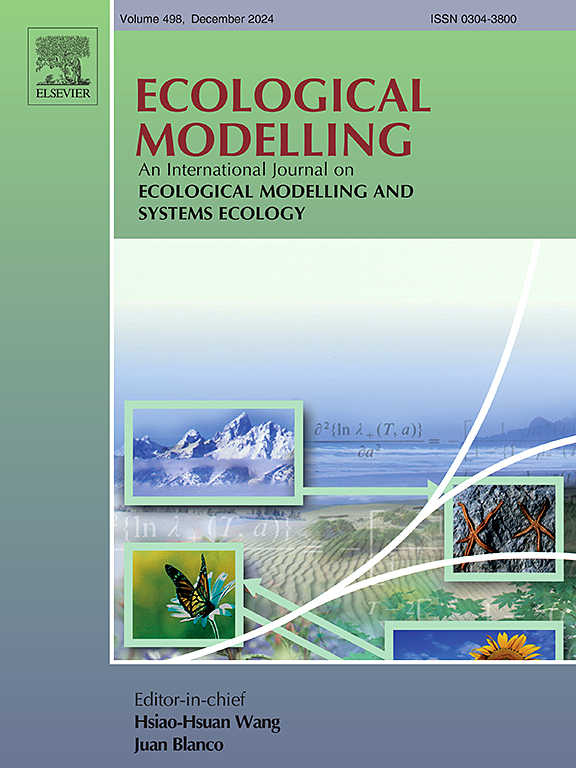Individual variation affects outbreak magnitude and predictability in multi-pathogen model of pigeons visiting dairy farms
IF 2.6
3区 环境科学与生态学
Q2 ECOLOGY
引用次数: 0
Abstract
Zoonotic disease transmission between animals and humans is a growing risk, and the agricultural context acts as a likely point of transition, with an important role of individual heterogeneity. Livestock often occurs at high local densities, facilitating spread within sites (e.g. among cows in a dairy farm), while wildlife is often more mobile, potentially connecting spatially isolated sites. Thus, understanding the dynamics of disease spread in the wildlife-livestock interface is crucial for mitigating these risks of transmission. Specifically, the interactions between pigeons (Columba livia, also known as ‘rock doves’) and in-door cows at dairy farms can lead to significant disease transmission and economic losses for farmers; putting livestock, adjacent human populations, and other wildlife species at risk. In this paper, we propose a novel spatio-temporal multi-pathogen model with continuous spatial movement. The model expands on the SEIRD framework and accounts for both within-species and cross-species transmission of pathogens, as well as the exploration–exploitation movement dynamics of pigeons, which play a critical role in the spread of infectious agents. In addition to model formulation, we also implement it as an agent-based simulation approach and use empirical field data to investigate different biologically realistic scenarios, evaluating the effect of various parameters on the epidemic spread. Namely, in agreement with theoretical expectations, the model predicts that the heterogeneity of the movement dynamics of pigeons (on top and beyond the obvious effect of an increase of mean level movement itself) can drastically affect both the magnitude and stability of outbreaks. In addition, joint infection by multiple pathogens can have an interactive effect, reflecting a non-intuitive inhibition of the outbreak compared to predictions from single-pathogen SIR models. Our findings highlight the impact of heterogeneity in host behavior on their pathogens and allow realistic predictions of outbreak dynamics in the multi-pathogen wildlife-livestock interface with consequences to zoonotic diseases in various systems.
在鸽子访问奶牛场的多病原体模型中,个体差异影响疫情规模和可预测性
人畜共患病在动物之间传播的风险越来越大,农业环境可能是一个过渡点,个体的异质性起着重要作用。牲畜在当地的密度通常很高,有利于在当地(如奶牛场的奶牛之间)传播,而野生动物的流动性通常更大,有可能将空间上孤立的地点连接起来。因此,了解野生动物与家畜之间的疾病传播动态对于降低这些传播风险至关重要。具体来说,奶牛场的鸽子(Columba livia,又称 "岩鸽")与室内奶牛之间的互动可能会导致重大疾病传播,给农民造成经济损失,并危及牲畜、邻近人类和其他野生动物物种。在本文中,我们提出了一种具有连续空间移动的新型时空多病原体模型。该模型在 SEIRD 框架的基础上进行了扩展,考虑了病原体的种内和跨种传播,以及在传染源传播中起关键作用的鸽子的探索-利用运动动态。除了模型的建立,我们还将其作为一种基于代理的模拟方法来实施,并利用经验性的现场数据来研究不同的生物现实场景,评估各种参数对流行病传播的影响。也就是说,与理论预期一致,模型预测鸽子运动动态的异质性(除了平均水平运动本身增加的明显影响之外)会极大地影响疫情爆发的规模和稳定性。此外,多种病原体的联合感染也会产生交互影响,与单病原体 SIR 模型的预测相比,会对疫情爆发产生非直观的抑制作用。我们的研究结果强调了宿主行为的异质性对其病原体的影响,并可对多种病原体的野生动物-家畜界面的爆发动态进行现实预测,从而对各种系统中的人畜共患疾病产生影响。
本文章由计算机程序翻译,如有差异,请以英文原文为准。
求助全文
约1分钟内获得全文
求助全文
来源期刊

Ecological Modelling
环境科学-生态学
CiteScore
5.60
自引率
6.50%
发文量
259
审稿时长
69 days
期刊介绍:
The journal is concerned with the use of mathematical models and systems analysis for the description of ecological processes and for the sustainable management of resources. Human activity and well-being are dependent on and integrated with the functioning of ecosystems and the services they provide. We aim to understand these basic ecosystem functions using mathematical and conceptual modelling, systems analysis, thermodynamics, computer simulations, and ecological theory. This leads to a preference for process-based models embedded in theory with explicit causative agents as opposed to strictly statistical or correlative descriptions. These modelling methods can be applied to a wide spectrum of issues ranging from basic ecology to human ecology to socio-ecological systems. The journal welcomes research articles, short communications, review articles, letters to the editor, book reviews, and other communications. The journal also supports the activities of the [International Society of Ecological Modelling (ISEM)](http://www.isemna.org/).
 求助内容:
求助内容: 应助结果提醒方式:
应助结果提醒方式:


